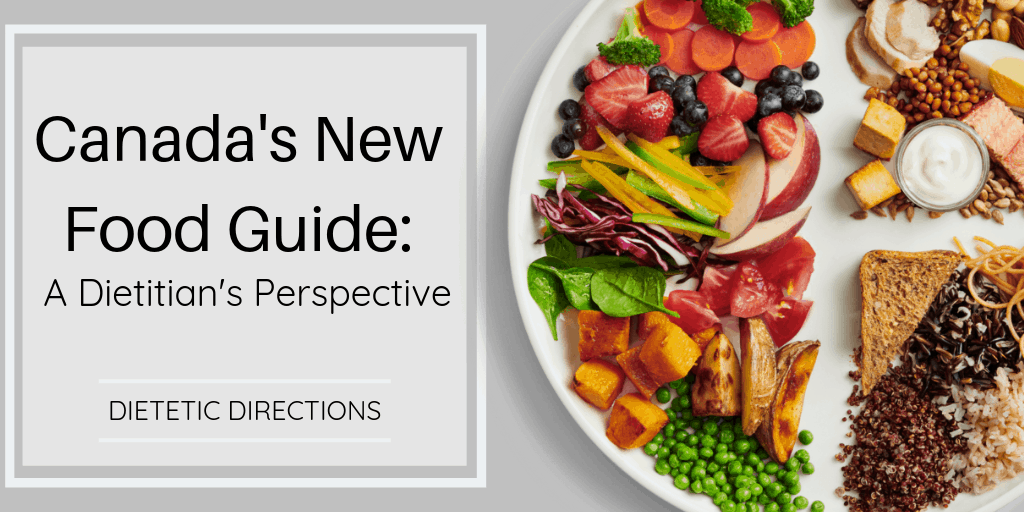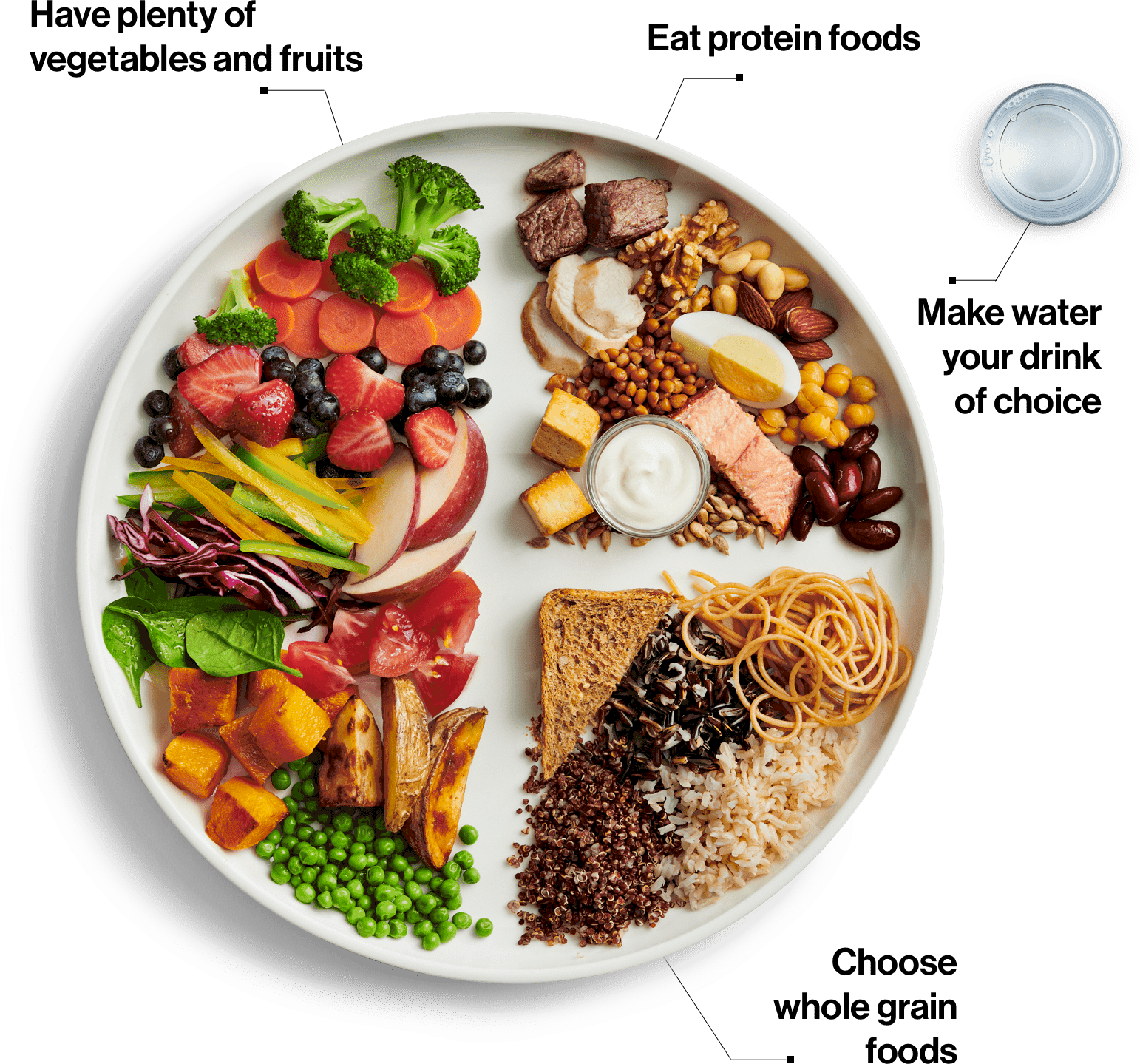
Canada’s New Food Guide
Canada’s New Food Guide was recently released. The last one was issued in 2007; a lot has changed in that time! We can say goodbye to the recognizable rainbow of four food groups. Many complained that it was too confusing and not individualized and that food industries heavily influenced it. Thankfully, Health Canada issued the new Food Guide after lengthy discussions with dietitians and the general public and consideration of evidence-based research to support its modern and relevant recommendations.
Our clients and valuable readers highly requested this blog. They wanted me to share my opinions about Canada’s New Food Guide changes. Today, I will highlight the purpose of the food guide, the top five changes and the pros and cons of this public educational tool.

It’s been since 2007 when the last Food Guide was issued; a lot has changed in that time! Find out now!
What is the Role of a Food Guide?
The Food Guide is a basic education tool designed to help people follow a healthy diet. This is by no means a one-size-fits-all, nor a descriptive analysis of what or how much to eat. Working with a Registered Dietitian is helpful for individualized recommendations along with counselling tools to facilitate behaviour change. (You can click here to work with one of the Dietitians on our team.)
Food Guides have evolved greatly since 1942 (click here for the evolution). They take into account current dietary patterns of the public, nutritional goals, along with food supply. They also consider nutritional science in order to recommend food choices while offering flexibility and variety in the diet.
“The Food Guide is a basic education tool designed to help people follow a healthy diet.”

5 Major Changes to Canada’s New Food Guide:
- Eliminated Four Food Groups: Instead, the public is encouraged to “eat a variety of healthy foods each day” including “plenty of vegetables and fruits, protein foods and whole grain foods.”
- No Serving Size Recommendations: Many people who do not measure or record their food intake found this confusing. The former recommendation was also not flexible for preferences and varying nutritional needs.
- Protein choices now encompass more plant-based proteins like tofu, beans and chickpeas, along with meat, fish, dairy, nuts/seeds, eggs, etc.

- Emphasis on drinking water: Clearly stating, “make water your drink of choice.” This displaces sugary beverages and calorically dense alcohol with associated health risks at high levels.

- Balanced Plate approach: Will see half plate fruit and vegetables, quarter protein and quarter whole grain. This might be overly simplistic for people uncertain of serving sizes, but it is a good place to start.
Pros of Canada’s New Food Guide:
- Absolutely love the broader approach emphasizing “how” we eat instead of simply what to eat. This includes “cook more often” as a practical and often overlooked aspect of healthy eating. Research clearly supports the nutritional benefits of cooking at home instead of eating out with highly processed products higher in calories, saturated fat, and sodium.

- Introduction to mindful eating – taking time to enjoy your food, not multi-tasking when eating. Notice the textures, flavours and visual appeal of your foods. Notice when you are hungry and when you are full.
- Emphasis to “eat with others” – the shared meal has so many health, psychological and food relationship benefits.

- Be aware of food marketing: This important note increases consumer awareness that products can be very deceptive in nutritional claims. The point is not elaborated upon, which is possibly a missed educational opportunity.
- Enjoy your food – Yes! As a food-loving dietitian and supporter of a healthy relationship with food that fuels your body in a feel-good way, I strongly favour this message. It’s simple but powerful and also encompasses enjoying cultural and food traditions.

- Emphasis on water for hydration. Again, this strategy is simple but powerful for meals.
Cons of Canada’s New Food Guide:
- Indicates consumers “use food labels” -Stating this very simplistically may confuse people unsure where to start. Click here for my blog on how to read and interpret the food label.

- Starchy Vegetables could be in the Grain group – I am a carb supporter (read here to see my blog on the importance of carbs); however, trying to account for carbohydrate energy, which comes from foods like grains, starches and fruits, confuses people. This diagram lumps the fruits, starchy vegetables and regular vegetables all in one category. I would have preferred the potatoes, peas, and squash included in a grains and starchy vegetable group. However, this would likely lead to more public confusion and possibly demonization of carbs.

- No note on supplementing with vitamin D; the previous food guide included this. It is difficult to get enough of this valuable nutrient in our diets. We also live in a sunshine-limited northern climate.

- Understated note on high-risk groups and how to adapt nutritional intake for elderly, pregnant/breastfeeding women, or children. However, as mentioned, the guide is a general tool, and your registered dietitian can make individual recommendations.
Bottom Line:
Overall, the new Canada’s Food Guide is a welcome update emphasizing mindfulness, cooking and eating together, and balancing your plate. The recommendations are no longer food group or portion specific. Their new flexibility includes a variety of foods with an emphasis on vegetables, plant-based proteins and whole grains.
The food guide could also note that working with a dietitian is a helpful tool for individualized recommendations. This would especially benefit the management of such health conditions as diabetes and heart disease, as well as digestive concerns. These all tremendously impact diets.

Now it’s your turn! What do you think about the changes to the Food Guide? What are your pros and cons?


